

27), and eggs were significantly more likely to hatch in the low concealment treatment (38 vs. 48), were significantly more likely to lay eggs in less concealed boxes (66 vs. Contrary to predictions, shamas placed nest material in the less concealed boxes significantly more often (89 boxes vs. We also compared vegetation characteristics of natural nest cavities with available natural nest cavities. Boxes were reset in new locations after a nest fledged or failed, providing 170 ‘choice' trials. Shamas were provided two boxes per territory, one with high and the other with low vegetation cover in front of the box entrance. We set 200 nest boxes in ∼100 territories of White-rumped Shamas (Copsychus malabaricus), territorial cavity nesters, in a seasonal evergreen forest in northeastern Thailand. We hypothesized that nesting success would be higher in nest cavities with more concealed entrances and therefore more likely chosen over less concealed cavities. It is often assumed that passerine birds conceal nests to reduce predation because nest predation is usually the primary cause of reproductive failure. Further research will be needed to identify key predators and broadly assess their foraging behaviors in individual landscapes. Our results suggest that the impacts of edge effects on the reproductive success of birds appear to be strongly dependent on the habitat preferences of locally dominant predators. There were no significant differences in timing of dispersal and dispersal distance or dispersal direction in relation to proximity to edge. Green cat snake (Boiga cyanea) and northern pig-tailed macaque (Macaca leonina), which likely prefer forest interiors over edges, were the primary predators of nests and fledglings in this landscape. Fledglings used locations with denser understory vegetation cover relative to the available habitat, probably to reduce predation risk. Predation had the strongest influence on survival, accounting for 100% of nest and 94% of fledgling mortality. Nest success and post-fledging survival were 11.6% and 23.6% higher at the edge versus the interior. We radio-tracked 50 fledglings from these boxes, 25 each for edge and interior, for 7 weeks after fledging. One hundred nest boxes were placed in forest interior (≥1,000 m from edge of a 5-lane highway) and 100 near forest edge (≤200 m) to assess nesting success.

We investigated the influence of road edge on nest success, post-fledging survival, and dispersal of White-rumped Shama (Copsychus malabaricus) in a dry evergreen forest in northeastern Thailand. This pattern is less clear in the tropics due to a lack of studies using natural nests and radio-tagged fledglings as well as an almost complete absence of information on nest and fledgling predators. Road edges in the temperate zone often negatively affect reproductive success, post-fledging survival, and dispersal of forest birds through processes associated with edge habitats. The White-rumped Shama (Muscicapidae: Turdinae: Copsychus mal-abaricus), introduced to Kauai in 193 1 by Alexander Isenberger, is native to South Asia, where there are four known subspecies: Copsychus m. Little is known about the biology of most of these species, and many were introduced without prior knowledge of their ecol-ogy or their potential for impact on Hawaiian ecosystems. The number of accidental or intentional introductions is now estimated at 178 (Berger 1981). Caum (1933) reported that 96 bird species had been introduced in Hawaii, and Bryan (1958) reported 94 introduced species. More species of birds have been introduced to Hawaii than to any other place (Long 1981). Shamas can raise two broods in one breeding season, and reproductive success for double-brooded pairs was higher (91%) than that for single-brooded pairs (62%). Both adults fed young but only the female incubated and brooded. The incubation period averaged 13.6 days and the nestling period averaged 12.4 days. Only three-and four-egg clutches were observed, with four eggs being the modal clutch size. The breeding season was from March through August, and territories of nesting pairs that were provided nest boxes averaged 0.09 ha in size.

It forms monogamous pair bonds that may last two breeding seasons. This species is sexually dichromatic and sexually dimorphic, with males being larger.

WC studied the breeding biology of the White-rumped Shama (Copsychus malabaricus) on Oahu, Hawaii, during 1986-1987.


 0 kommentar(er)
0 kommentar(er)
